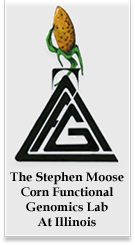The Energy Maize Concept
Project Overview
Concerns regarding future energy sources, both environmental and economical, loom large on our horizon. Opinions about what these venues should eventually be are varied and all have different approaches, although most agree that these sources should be renewable and practical. One of the proposed methods for ‘second-generation’ biofuels, also referred to as cellulosic biofuels, makes use of the vegetative portion of plant materials. Thus, obtaining a greater understanding of plant biomass production is a desirable goal, especially for grass species.
Corn, both as a crop and as a research platform, has a number of advantages
in this regard :
it is well-researched when compared to other suggested biofuel crops,
both agronomically and genetically, and is grown all over the world. Striking
differences in height and girth of hybrids made from daylight-sensitive
tropical inbreds and U.S. inbreds have been well observed in the past,
which suggests that the regulation of biomass accumulation in corn can
potentially be exploited for cellulosic biofuels. In conjunction with
our lab’s previous work on flowering time genes (Glossy15, see also The
Leaf Identity Project) and their effects on vegetative phenotype,
we hypothesize that the control of vegetative and reproductive phase change.
This may lead to possible alterations of biomass-related phenotypes in
corn and, as it involves a system conserved across plant families, potentially
in other crops.
Using gene expression analysis and sequencing techniques, we are attempting to elucidate an observable link between phase change and biomass accumulation, as well as the role that nitrogen partitioning play in this system in order to investigate the potential of corn as a cellulosic biofuel source.
